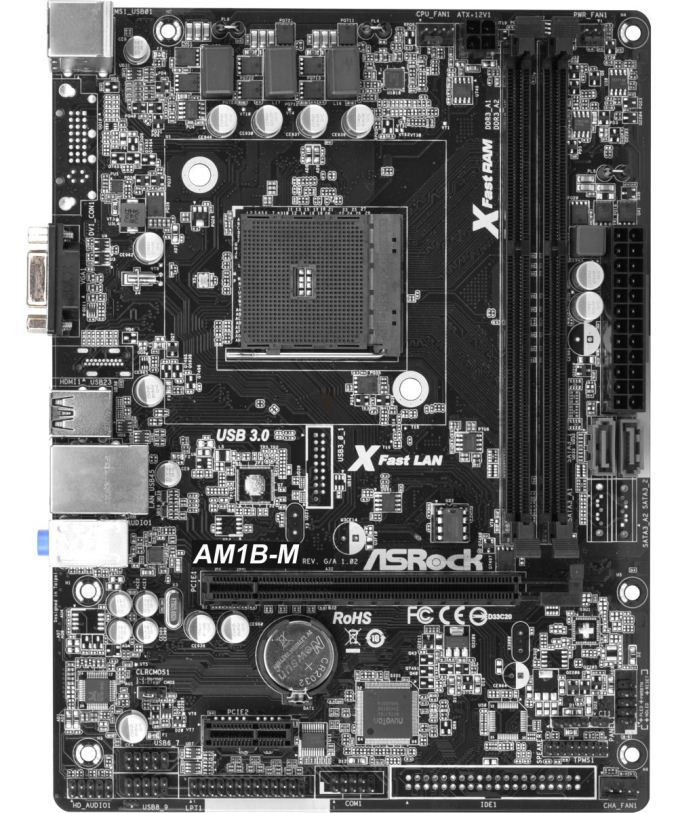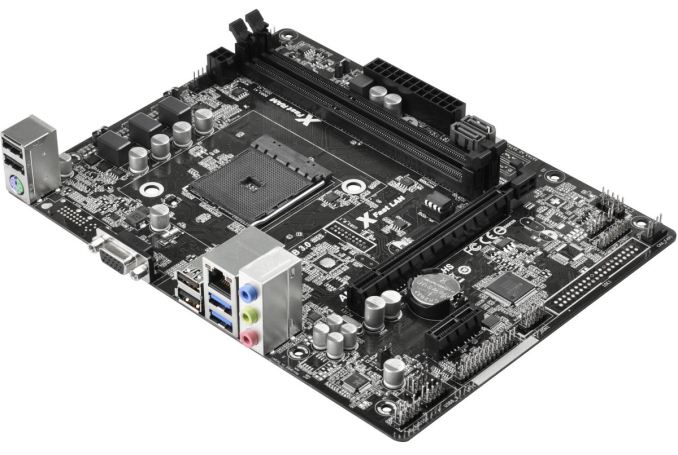The AM1 Kabini Motherboard Preview: Analyzing the Hardware
by Ian Cutress on April 19, 2014 2:00 PM ESTASRock AM1B-M
ASRock’s first motherboard falls under the $40 mark and also represents a slightly different variation on the theme. So far no two motherboards have been alike, and the ASRock AM1B-M exchanges the higher audio and video outputs instead for more rear USB 2.0 ports and an extra fan header. On the face of it, this does not seem like a good deal compared to the previous MSI, unless you need extra USB 2.0 ports.
The AM1B-M seems to have a lot of spots unoccupied by connectors. This is mostly likely due to variations of products, where the cheapest tends to have expensive connectors removed to hit a price point. We see two SATA ports missing, an IDE pin layout but no connector, and also a DVI connection missing on the rear panel. In the middle of the board is also a USB 3.0 pin layout, suggesting that another model has an additional USB 3.0 controller as well.
What the ASRock AM1B-M also does differently to all the motherboards we have examined before now is include a COM port, LPT port and a TPM port on the same PCB. It would be interesting to see which niche that combination would be good for.
The PCIe layout uses the PCIe 2.0 x4 from the chipset in a full sized slot, with an additional PCIe 2.0 x1 underneath. Thankfully the SATA ports are alternate facing for removing locking SATA cables, and the placement of the 4-pin CPU connector also helps cable routing. The AM1B-M has three fan headers, one more than the others – two on the top of the motherboard either side of the DRAM slots, and a third on the bottom right.
The AM1B-M has four USB 2.0 ports on the rear panel, or what I like to call my happy minimum (installing an OS via USB helps with at least three USB 2.0 ports). That being said, the sole VGA connector looks lonesome, and the ALC662 audio codec is not a particularly good choice.
| ASRock AM1B-M | |
| Price | Link |
| Size | Micro-ATX |
| CPU Interface | FS1b |
| Chipset | Kabini |
| Memory Slots |
Two DDR3 DRAM slots, supporting 16GB Single Channel, 1066-1600 MHz |
| Video Outputs | VGA (2048x1536 at 60 Hz) |
| Onboard LAN | Realtek RTL8111GR |
| Onboard Audio | Realtek ALC662 |
| Expansion Slots |
1 x PCIe 2.0 x16 (x4) 1 x PCIe 2.0 x1 |
| Onboard SATA/RAID | 2 x SATA 6 Gbps |
| USB 3.0 | 2 x USB 3.0 (Chipset) [rear panel] |
| Onboard |
2 x SATA 6 Gbps 2 x USB 2.0 headers 3 x Fan Headers 1 x TPM Header 1 x LPT Header 1 x COM Header Front Panel Header Front Audio Header |
| Power Connectors |
1 x 24-pin ATX 1 x 4-pin CPU |
| Fan Headers |
1 x CPU (4-pin) 1 x CHA (4-pin) 1 x SYS (3-pin) |
| IO Panel |
1 x PS/2 Combination Port VGA 2 x USB 3.0 4 x USB 2.0 1 x Gigabit Ethernet Audio Jacks (ALC662) |
| Product Page | Link |














64 Comments
View All Comments
rRansom - Sunday, April 20, 2014 - link
Test acknowledged.Samus - Monday, April 21, 2014 - link
I got it too.Ortanon - Monday, April 21, 2014 - link
lollmcd - Saturday, April 19, 2014 - link
The MSI would do better to have antenna and an attach point for everything for 2-3 $ more.lmcd - Saturday, April 19, 2014 - link
The commentary on the ASRock AM1H-ITX price misses the mark -- the benefits of the DC laptop power option mean that a tiny case attached to a VESA mount can be more easily used. Also, aren't such power supplies cheaper?teldar - Monday, April 21, 2014 - link
I built one with the a asrock am1h and didn't even use a case. It's screwed to a piece of lexan and th e ssd is stuck underneath it.MonkeyPaw - Saturday, April 19, 2014 - link
I would love to see some tests with GPUs installed. Since the jaguar core is also used in the latest consoles, I'm curious to see what happens when you drop comparable GPUs (to the new consoles) inside. Can the PS4/XboxOne even make good use of all that GPU power with such a basic CPU? Do it for science!wolrah - Saturday, April 19, 2014 - link
A tricky difference with the consoles is that they get twice the cores compared to retail offerings.tuxRoller - Saturday, April 19, 2014 - link
http://www.phoronix.com/vr.php?view=20215You're welcome:)
MonkeyPaw - Saturday, April 19, 2014 - link
I saw that, but it's on Ubuntu, which isn't quite up to speed as Windows.Also, while I know the new consoles have 8 cores, they run at lower clocks than the 5350. I also have my doubts that most games can use all 8 cores effectively. I think they are there more for better multitasking. Like I said, it would be interesting to see what a mid-range GPU could do here. Would it be worth it to spend $80 on AM1 and $150 on a GPU, or would that $230 go further another way, like with an A10-7850K? Which would make a better budget gaming combo? You might also be able to skimp on RAM with AM1 since you'll have a dedicated GPU will